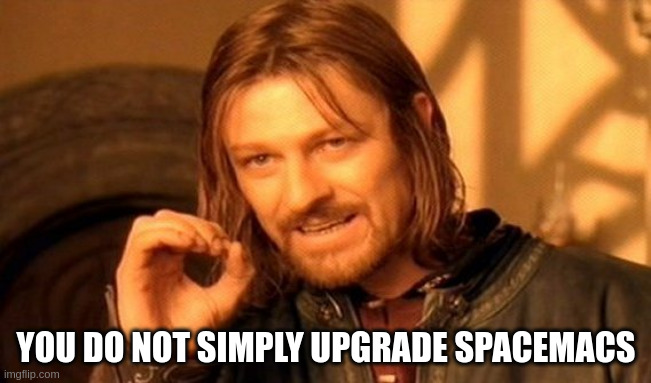Upgrading Spacemacs
Table of Contents
Spacemacs consists of 2 parts,
- Spacemacs to manage and configure a set of third-party Emacs packags and
- the third-party packages themselves.
The Spacemacs code itself is continuously updated. These update bring new features and fix bugs, or contain changes to take into account features or bugs in the third-party packages. This means Spacemacs is coupled to the state of the most-recent third-party packages. As Boromir would tell you,

To avoid any issues, I always update Spacemacs from scratch whenever I update Spacemacs. This means I have to update my Spacemacs configuration, and install the latest versions of the third-party packages. The last time I did that was than a year ago - October 19, 2022 - and it was time for an update.
The update itself…
The actual update seemed to go smoothly. However, after a few minutes of using
Spacemacs, the buffer with key bindings for multi-key commands didn’t show up
anymore. I use the buffer extensively so this was a shows stopper. Some
googling1 lead me to issue spacemacs#16276, “Keyboard + Command hints stop
showing”. It turned out that a recent update to package helm-descbinds package
disabled the mode that shows the key bindings, which-key. This issue comment
contained a workaround I added to my Spacemacs config2.
helm-descbinds is part of Emacs-Helm, a “framework for incremental completions
and narrowing selections”. Spacemacs uses Helm everywhere to let you easily
select a candidate from a large list of candidates, for example to select a file
from a directory tree, or in the case of helm-descbinds, an entry from the
complete list of keys and the functions they bind.
The candidates come from one or more “sources”. When Helm shows you the
candidates, it uses the source names as headers in the candidate list. In my
previous Spacemacs config, I could go from source to source but now Helm only
let me cycle through the candidates of the current source. I found out that to
move to the next source, I had to use a separate keystroke, C-h. This behavior
is managed by variable helm-move-to-line-cycle-in-source, whose default had
changed in a recent commit to Helm. I prefer the previous behavior so I
configured the original default.
Back to helm-descbinds, another very recent commit, “Make display more fancy”,
adds some “fancy” formatting to display the keys and their functions. For me,
the formatting makes the list look messy and less clear. So I restored the
original, plain formatting in my Spacemacs config.
There was another visual change to Helm: the buffer of candidates shows a help
message below the mode line. The first time you see this help you might think
“good to know” but for each helm command, it’s always the same message. This
help message is called “persistent help” and thanks to issue helm#1948, I found
out that you can disable it by setting helm-display-header-line to nil.
Unfortunately this leads to a minor visual glitch when you run Emacs in a
terminal3, but you win some, you lose some.
Summarizing, the update itself took 10 minutes, but addressing the showstopper and restoring some previous behavior took me several hours. Once a year, it’s a small investment in the improvements the latest versions of Spacemacs and the third-party packages bring.
Other changes
When I decided to update Spacemacs, I also wanted to improve some other aspects of my Spacemacs config. One of them was the way I managed changes to my config for different workstations. The original idea was to use one Git branch for each workstation. A drawback is that you have to cherry pick changes from one branch to another to keep all the active ones up-to-date. I hardly ever did that so in practice I was maintaining a single branch with local, uncommitted changes.
So I decided to use a different approach: work from a single branch and keep all workstation-specific changes in a separate workstation-specific file. Up till now that works better than the multi-branch approach, allthough there are still some environment-specific details in the shared user config.
The README of my Spacemacs config repo contained the Emacs Lisp code of my user config and you would generate that config from it. It also held the code for 2 bash scripts. This looked nice but in the end the extra steps of this literate programming approach weren’t worth it. Currently the README is just a README, the user config a standalone Emacs lisp file and the single remaining bash file a standalone bash file4.
The final change worth mentioning is that I added Emacs support for the Git repo of yadm, a dotfile manager. yadm uses a bare Git repo with your home directory as a work tree but magit, a very good Git porcelain in Emacs, doesn’t support it. However, there is a way to use magit for yadm. I stumpled upon this Emacs List snippet to configure access using to the yadm repo over Tramp. Tramp is an Emacs package that “provides an […] interface to editing remote files […] as if they were local”. It exposes the contents of the bare Git repo as local files to magit5.
At the moment I use Kagi instead of Google for my web searches, but that’s another story. ↩︎
A week later, this update to Spacemacs uses a new option of
helm-descbindsto not disablewhich-key. I still rely on the workaround. ↩︎When you run Emacs in the terminal and use
helm-display-header-lineequal tonil, the minibuffer shows a cursor that moves with your input to the helm session. It only shows and moves the cursor, it doesn’t show the characters you type. ↩︎There were 2 bash files,
emacs-nw.elto start an Emacs client in terminal mode andmagit.elto start Magit in terminal mode. I deleted the latter because I never used it. ↩︎Later I found that this approach is described in the yadm man page as well. ↩︎